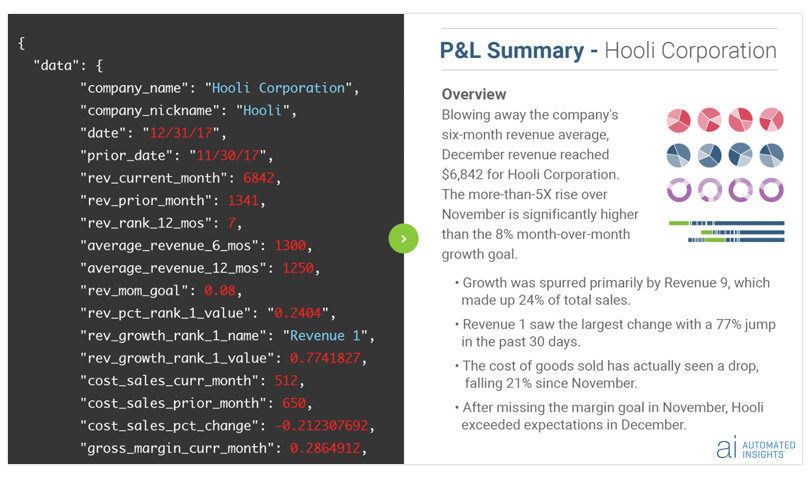Wordsmith: AI-powered Narratives in Human-Friendly Prose

Wordsmith is using Natural Language Generation (NLG) to create written analysis in a heartbeat.
The next AP article you read on Apple’s second quarter earnings might not be written by humans. Not by aliens either, but by a powerful natural language generation (NLG) platform called Wordsmith. Developed by business intelligence company Automated Insights, Wordsmith takes in structured data, uses AI to interpret it, and spits out human-friendly prose narratives such as summaries, headlines, and articles that explain said data. Wordsmith is sold in a SaaS format, with background computations and analysis done in the cloud.
While the platform won’t be churning out a Pulitzer-winning article anytime soon, it does save writers considerable time by automatically fleshing out the simpler, “low hanging fruit” insights, and could even come up with a few unique insights that the user didn’t consider. Going back to the Apple example, a business journalist might input the company’s quarterly financials into Wordsmith and the platform will return a few blurbs on how revenue increased x% YoY, commentary on EBITDA margin evolution, and insights on the volume of iPads sold.
The possibilities of this platform seem endless, going beyond journalism and into basically any situation (including personal and professional settings) that requires making sense of data. Examples include writing internal company memos, creating end of quarter presentations, or gaining insights from your bank account activity. According to a report from the International Data Corporation, global data generation will likely increase to about 163 zettabytes (sextillion bytes) by 2025, which means that we will need all the help we can get in making sense of it all.
While Wordsmith is making substantial progress in helping users interpret vast amounts of data, it still has a long way to go in terms of ease of use and how “natural” its NLG output actually sounds. Wordsmith users on software review website G2 note that, while the platform has saved them hours in processing and interpreting data, its dashboards can be overwhelming and confusing at times. Initial set up time is also a common pain point, described as time consuming and highly technical. There is also room for improvement on the NLG output, which sometimes sounds too “robotic” and requires that users go back and give it the human touch.
User experience issues such as ease of use are probably a straight-forward fix for Automated Insights, which should be able to iron them out as it collects more user feedback. As for the quality of NLG output, improvement will depend on how powerful its underlying AI technology is, which determines the platform’s capacity to learn and refine after each iteration. Beyond these two fronts, Automated Insights can further its mission to help make sense of the world’s data by developing integrations with other popular business intelligence solutions. Its partner network already includes important players such as Tableau, and by further expanding this network the company will ensure its relevance in the space and facilitate adoption by organizations and individual users.
Looking forward, one could reasonably expect that AI capabilities such as Wordsmith’s will become even more powerful and sophisticated, enabling full writeups with vivid, human-like commentary at the click of a button. Automated Insights should tread carefully as its technology progresses – in an ideal future, data interpretation will remain clear, objective, and impartial. However, this is an unlikely scenario, seeing as how we’re already highly adept at bending information to suit our needs (without the help of any sophisticated technology). The ability to generate toxic, manipulative, or dangerous narratives in an instant could open (even more) the floodgates to misinformation, so Automated Insights should place extra care in ensuring that its AI technology remains fully impartial. Leave political commentary to humans, and maybe a robot might snatch a Pulitzer after all.
https://sourceforge.net/articles/qa-automated-insights-business-intelligence-analytics-natural-language-generation-wordsmith/




A very fascinating application of AI indeed! I am curious to know if using a machine to write an article would venture into the area of plagiarism as the machine would be using existing data to learn how to write (could be a possibility of lifting phrases directly). But I agree that the applications are wide – especially for those with disabilities. Thank you for the post.
Really cool Rolando! An interesting application I see for something like this is content marketing, a medium that is becoming quite common for companies to use to increase awareness for their products. While in its current form this product “funnels down” information, meaning that it seems to summarize important insights from a large text, I wonder how powerful it could be for going the other way: from some key insights, generate a blog post or article. As a startup founder reflecting on how to balance my scarce resources, this type of solution could save valuable time in content marketing efforts for me.